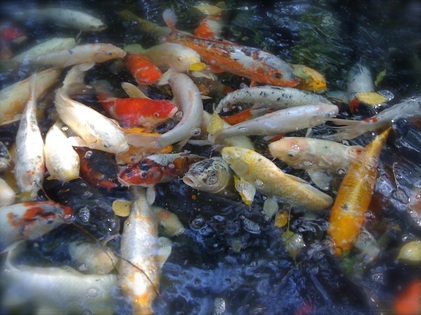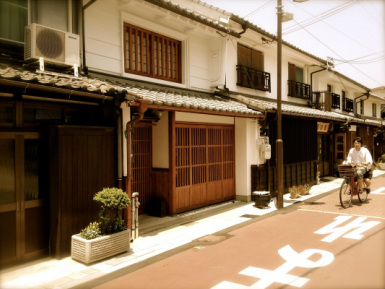|
Must be May; the sound of running water is everywhere, rushing through the sluiceways and gushing from the culverts of the Good Hood. It’s ta-ue, the time when every slip of cultivated earth not yet paved over is flooded and planted with rice seedlings. Soon will come the frogs, then the hungry paddy snakes and after them the sky will be dark with dragonflies.
Air space over the Good Hood is already crowded. Those damn noisy bulbuls outside my front door, looting and pillaging the gardens of the hood as they do every year before the wet season humidity drives them back to the mountains. But give me squabbling bulbuls any day; when the nauseating drone of cicadas arrives after the wet, neighborly conversation becomes a cross-street shouting match and sleeping late is only for the elderly, the dead and owners of heavy industry ear plugs. But now time to enjoy the cool, quiet evenings. Almost quiet; that new bugle player from the Self Defence Force (SDF) base up the road must be on loan from the Ueshima Underwater Orchestra (UUO). His Taps and Reveille sound like a bulbul with the flu. But enough of the bird flu... More and more I’ve come to recognise the denizens of the Good Hood by their sounds. Pre-dawn brings the Opera Singer, an elderly woman who cycles by my house singing songs from old Japanese operas. Her voice is strong and feminine. I have never seen her face. There is the Running Man who appears after dark on weekdays. He sprints the length of the street, the bata-bata-bata of his rubber soles like a machine gun on the pavement. Night-time also brings the Newspaper Dude, the screech of his bicycle brakes his signature, a lingering tail of cigarette smoke his calling card. His female counterpart is The Drill Rider, a female shift worker who rides an electric bicycle that sounds like a high-speed dentist’s drill. If I miss the Opera Singer at 6am, there is always Miss High Heels who passes at a tottering gallop as she tries to make the 7.05 city bus. In my half-dreams I imagine a camel in stilettos. I have never seen her face. And there are other sounds: The loose sheet of rusting iron on a house down the road indicates wind strength, rattling violently in typhoon season. The screams from the English teacher's house across the road as he makes love to his girlfriend in his lunch hour. A housewife arguing with her mother-in-law. Mother-in-laws talking about their lazy daughter-in-laws. My neighbour discussing the high price of kerosene with my other neighbour. The baby screaming above the Funabiki Barber Shop. Maekawa-san scolding her two shitsu dogs for pooing outside the barber shop. The kendo club across the Semba River whose clack-clack of wooden swords sounds likes a gazillion raining chopsticks. And finally, the rhythmic, hypnotic chant of the Himeji Kogyo Highschool baseball team as they do their calisthenics. This is a day in the life of a small Japanese neighborhood—told in sound.
2 Comments
From 1000 metres above Earth my neighborhood looks like an overcrowded circuit board; a dense cluster of houses spanning a century in design, dissected by a winding river called the Semba, and at the centre, a long narrow street on which sits a 100-year-old house made of bamboo, mud and clay tiles. My home for the past 14 years.
I could describe this project as ‘peeling back the layers of the onion’ or like ‘dipping a jar into a river to capture all the weird and wonderful organisms that co-exist in it’—but I won’t. I’ll simply tell my neighborhood like it is, each week with a new perspective. Naming it would be ‘localising’ too much, so let’s just call it the Good Hood--an average neighborhood in a city called Himeji (pop. 550,000), located 50km west of Kobe in western Honshu. Like any other in Japan, it has a Shinto shrine, Buddhist temple, barber shop, hair salon, highschool, 7-Eleven, yakitori restaurant, post office, liquor shop, summer and autumn festivals and a traditional shopping street lined with turn-of-the-century town houses, or machiya. And through it all wends a small river whose depth and flow reflect the seasonal moods of western Honshu. Time has gathered the old communities into towns and cities, even turned some into metropolises, but the cho, or neighborhood, remains the heart and soul of Japan. Roll back my sliding door, step out onto a jute door mat (favoured by the local stray) and I stand on a street strung with an impossible number of power and telephone lines. To the north lies the Shinto shrine with its ancient wood pavilion guarded by dragons and fearsome stone lion-dogs. To the south, where the paddies have been smothered by new homes, young housewives gather to chew over their boring lives and await their kids return from school. Long after dark, the buses will disgorge their tired ‘salarymen’ husbands who drift heavy-hearted back to their homes and sleeping families. Japan’s population is 127 million and falling; my neighborhood (23 houses) is about 127 people and also falling. As the population ages and old family houses are abandoned and left to their own devices, they attract new inhabitants: birds, insects, reptiles, runaway pets and other exotic animalia. But let me tell you about that some other time. It’s this ‘devolving’ of my neighborhood that motivates me to tell you about its sights, sounds, smells, quirky rituals and personal charm before they disappear altogether! Next week: Sounds of the Good Hood. |
This Blog:What is the essence of a traditional Japanese neighbourhood? Writing from my home in Himeji, a castle town in western Honshu, Seaweed Salad Days distills, ferments, presents! Archives
March 2024
Categories
All
|


 RSS Feed
RSS Feed
